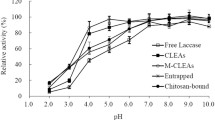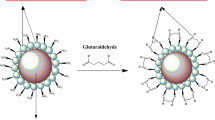Abstract
Maillard reaction products like melanoidins are recalcitrant, high-molecular-weight compounds responsible for colour in sugarcane molasses distillery wastewater. Conventional biological treatment is unable to break down melanoidins, but extracellular laccase and manganese peroxidase of microbial origin can degrade these complex molecules. In this work, laccase was covalently immobilized on alumina pellets activated with aminopropyltriethoxysilane (APTES). The immobilization yield was 50–60 %, and the enzyme activity (886 U/L) was 5-fold higher compared to the soluble enzyme (176 U/L). The immobilized enzyme also showed higher tolerance to pH (4–6) and temperature (35–60 °C), as well as improved storage stability (49 days) and operational stability (10 cycles). Degradation of glucose-glycine Maillard products using immobilized laccase led to 47 % decolourization in 6 h at pH 4.5 and 28 °C. A comprehensive treatment scheme integrating enzymatic, microbial and membrane filtration steps resulted in 90 % decolourization.





Similar content being viewed by others
References
Wedzicha, B. L., & Kaputo, M. T. (1992). Melanoidins from glucose and glycine: composition, characteristics and reactivity towards sulphite ion. Food Chemistry, 43, 359–367.
Reynolds, T. M. (1963). Chemistry of non-enzymatic browning of the reaction between aldoses and amines. In Advances in Food Research (Vol. 2, pp. 1–52). New York: Academic Press.
Morales, F., & Jimenez-Perez, S. (2001). Free radical scavenging capacity of Maillard reaction products as related to color and fluorescence. Food Chemistry, 72, 119–125.
Cämmerer, B., Jalyschkov, V., & Kroh, L. W. (2002). Carbohydrate structures as part of the melanoidin skeleton. International Congress Series, 1245, 269–273.
Manisankar, P., Rani, C., & Vishwanathan, S. (2004). Effect of halides in the electrochemical treatment of distillery effluent. Chemosphere, 57(8), 961–966.
Chavan, M. N., Kulkarni, M. V., Zope, V. P., & Mahulikar, P. P. (2006). Microbial degradation of melanoidins in distillery spent wash by an indigenous isolate. Indian Journal of Biotechnology, 5(3), 416–421.
Yadav, S., & Chandra, R. (2012). Biodegradation of organic compounds of molasses melanoidin (MM) from biomethanated distillery spent wash (BMDS) during the decolourisation by a potential bacterial consortium. Biodegradation, 23(4), 609–620.
Yadav, S., Chandra, R., & Rai, V. (2011). Characterization of potential MnP producing bacteria and its metabolic products during decolourisation of synthetic melanoidins due to biostimulatory effect of d-xylose at stationary phase. Process Biochemistry, 46(9), 1774–1784.
Yadav, S., & Chandra, R. (2013). Detection of persistent organic compounds from biomethanated distillery spent wash (BMDS) and their degradation by manganese peroxidase and laccase producing bacterial strains. Journal of Environmental Biology, 34, 755–764.
Solomon, E. I., Sundaram, U. M., & Machonkin, T. E. (1996). Multicopper oxidases and oxygenases. Chemical Reviews, 96, 2536–2605.
Liu, Y., Zeng, Z., Zeng, G., Tang, L., Pang, Y., Li, Z., Liu, C., Lei, X., Wu, M., Ren, P., Liu, Z., Chen, M., & Xie, G. (2012). Immobilization of laccase on magnetic bimodal mesoporous carbon and the application in the removal of phenolic compounds. Bioresource Technology, 115, 21–26.
Cristovao, R. A., Tavares, A. P. M., Brigida, A. I., Loureiro, J. M., Boaventura, R. A. R., Macedo, E. A., & Coelho, M. A. Z. (2011). Immobilization of commercial laccase onto green coconut fiber by adsorption and its application for reactive textile dyes degradation. Journal of Molecular Catalysis B: Enzymatic, 72, 6–12.
Wang, F., Guo, C., Yang, L., & Liu, C. Z. (2010). Magnetic mesoporous silica nanoparticles: fabrication and their laccase immobilization performance. Bioresource Technology, 101, 8931–8935.
Zhu, Y., Kaskel, S., Shi, J., Wage, T., & van Pee, K. H. (2007). Immobilization of Trametes versicolor laccase on magnetically separable mesoporous silica spheres. Chemistry of Materials, 19, 6408–6413.
Zille, A., Tzanov, T., Gübitz, G. M., & Cavaco-Paulo, A. (2003). Immobilized laccase for decolourization of reactive black 5 dyeing effluent. Biotechnology Letters, 25(17), 1473–1477.
Takahashi, H., Li, B., Sasaki, T., Miyazaki, C., Kajino, T., & Inagaki, S. (2001). Immobilized enzymes in ordered mesoporous silica materials and improvement of their stability and catalytic activity in an organic solvent. Microporous and Mesoporous Materials, 44–45, 755–762.
Wang, F., Hu, Y., Guo, C., Huang, W., & Liu, C. Z. (2012). Enhanced phenol degradation in coking wastewater by immobilized laccase on magnetic mesoporous silica nanoparticles in a magnetically stabilized fluidized bed. Bioresource Technology, 110, 120–1244.
Bayramoğlu, G., Yilmaz, M., & Arica, M. Y. (2010). Reversible immobilization of laccase to poly(4-vinylpyridine) grafted and Cu(II) chelated magnetic beads: biodegradation of reactive dyes. Bioresource Technology, 101(17), 6615–6621.
Costa, S. A., Tzanov, T., Paar, A., Gudelj, M., Gübitz, G. M., & Cavaco-Paulo, A. (2001). Immobilization of catalases from Bacillus SF on alumina for the treatment of textile bleaching effluents. Enzyme and Microbial Technology, 28(9-10), 815–819.
Arica, M. Y., Altintas, B., & Bayramoglu, G. (2009). Immobilization of laccase onto spacer-arm attached non-porous poly(GMA/EGDMA) beads: application for textile dye degradation. Bioresource Technology, 100, 665–669.
Fernando, B. L., Morales, G., & Sanz, R. (2010). Immobilization strategies for laccase from Trametes versicolor on mesostructured silica materials and the application to the degradation of naphthalene. Bioresource Technology, 101, 8541–8548.
Dahiya, J., Singh, D., & Nigam, P. (2001). Decolourisation of molasses wastewater by cells of Pseudomonas fluorescens immobilised on porous cellulose carrier. Bioresource Technology, 78(1), 111–114.
Basri, H., Ismail, A. F., & Aziz, M. (2011). Polyethersulfone (PES)-silver composite UF membrane: effect of silver loading and PVP molecular weight on membrane morphology and antibacterial activity. Desalination, 273, 72–80.
APHA. (1995). Standard method for the examination of water and wastewater, 19th ed (pp. 512–513). Washington, DC: American Public Health Association. 5220B.
Wei, J., Shi, J., Pan, H., Su, Q., Zhu, J., & Shi, Y. (2009). Thermal and hydrothermal stability of amino-functionalized SBA-16 and promotion of hydrophobicity by silylation. Microporous and Mesoporous Materials, 117, 596–602.
Wei, J., Shi, J., Pan, H., Zhao, W., Ye, Q., & Shi, Y. (2008). Adsorption of carbon dioxide on organically functionalized SBA-16. Microporous and Mesoporous Materials, 116, 394–399.
Guisan, J. M., Melo, F. V., & Ballesteros, A. (1981). Determination of intrinsic properties of immobilized enzymes. Applied Biochemistry and Biotechnology, 6, 25–36.
Dehghanifard, E., Jafari, A. J., Kalantary, R. R., Mahvi, A. H., Faramarzi, M. A., & Esrafili, A. (2013). Biodegradation of 2,4-dinitrophenol with laccase immobilized on nano-porous silica beads. Iranian Journal of Environmental Health Science and Engineering, 10, 25–35.
Nicolucci, C., Rossi, S., Menale, C., Godjevargova, T., Ivanov, Y., & Bianco, M. (2011). Biodegradation of bisphenols with immobilized laccase or tyrosinase on polyacrylonitrile beads. Biodegradation, 22(3), 673–683.
Champagne, P. P., & Ramsay, J. (2010). Dye decolorization and detoxification by laccase immobilized on porous glass beads. Bioresource Technology, 101(7), 2230–2235.
Kunamneni, A., Ghazi, I., Camarero, S., Ballesteros, A., Plou, F. J., & Alcalde, M. (2008). Decolorization of synthetic dyes by laccase immobilized on epoxy-activated carriers. Process Biochemistry, 43(2), 169–178.
Kato, H., & Tsuchida, H. (1981). Estimation of melanoidin structure by pyrolysis and oxidation. Progress in Food Nutrition Science, 5, 147–156.
Cammerer, B., & Kroh, L. W. (1995). Investigation of the influence of reaction conditions on elementary composition of melanoidins. Food Chemistry, 23, 55–59.
Victorio, J. D., Buquiran, D. P., & Rosario, E. J. (2007). Decolorization of glucose-glycine melanoidin as model color pollutant using ozonation and bacterial treatment. Philippine Journal of Science, 136(1), 65–73.
Acknowledgments
This work was supported by the Department of Science and Technology, Government of India (No. W-11035/25/2010-R&D/W.Q), and Research Foundation Flanders (FWO) for the Indigo-funding (G.0808.10N) and a membrane fouling project (FWO G.0808.10N), the Government of Belgium, for an I.A.P-P.A.I. grant (IAP 7/05 FS2) and the KU Leuven Research Council for an IOF-knowledge platform (IKP/10/002 IOF). The supply of enzyme from Novozymes, India, is gratefully acknowledged. We thank Dr Prem Dureja (The Energy and Resources Institute, New Delhi, India) for the GC-MS analysis.
Author information
Authors and Affiliations
Corresponding author
Additional information
Highlights
• Laccase immobilized on alumina support tested for melanoidin degradation
• Organic reduction occurs on microbial treatment of laccase-treated melanoidins
• Membrane filtration required for residual colour and organic removal
Electronic supplementary material
Below is the link to the electronic supplementary material.
ESM 1
(DOC 129 kb)
Rights and permissions
About this article
Cite this article
Singh, N., Basu, S., Vankelecom, I.F.J. et al. Covalently Immobilized Laccase for Decolourization of Glucose-Glycine Maillard Products as Colourant of Distillery Wastewater. Appl Biochem Biotechnol 177, 76–89 (2015). https://doi.org/10.1007/s12010-015-1729-5
Received:
Accepted:
Published:
Issue Date:
DOI: https://doi.org/10.1007/s12010-015-1729-5




